You are using an out of date browser. It may not display this or other websites correctly.
You should upgrade or use an alternative browser.
You should upgrade or use an alternative browser.
Technical Ducato P0401 P0402 P0236 P0238 and limp mode its 2017 Euro 6, EGR changed, What do I check next
- Thread starter Fredastaire
- Start date
Currently reading:
Technical Ducato P0401 P0402 P0236 P0238 and limp mode its 2017 Euro 6, EGR changed, What do I check next
kangexpress
Member
Exhaust pipe is black and sticky from inside.Is your exhaust pipe clean or is there any black resuidue?
And its producing black smoke.
Small amount.
But it's there.
If you press the gas paddle few times at zero speed you will see light black colour coating on the ground. Like somebody sprayed with black color spray from a far distance.
Also I've done some further testing today.
MES results attached.
I've cut a brake cleaner bottle in half and drilled a hole inside to block the exhaust pipe partly with it.
Goal was to see if there is back pressure on the LPEGR cooler and LPEGR, if the turbo charger than is responding properly.
Result was no change in turbo pressure reading at zero speed and rev up to 2000.
And differental pressure just moved from 2 mbar to 6 mbar. Not much for a blocked exhaust.
I couldn't see or hear any leak on exhaust system from anywhere else.
Exhaust pipe was producing a lot of pressure at exhaust.
That's why I couldn't do a test drive with the blocked exhaust pipe.
Even fixed with cable tie, cut bottle would come off immediately under boost pressure.
I've then done a test drive today without the blocked exhaust.
What I've noticed is that turbocharger isn't producing enough boost pressure under partial load.
Couldn't find the problem yet.
Maybe the new (remanufactured original) turbo charger has bad settings?
And that's why in second stage the EGR doesn't get enough exhaust flow and the EGR code pops up?
I've noticed that under partial load, when the LPEGR is open, the actual boost pressure is up to 500 mbar lower than the desired boost pressure.
Under full load there is no gap between desired and actual boost pressure.
I've noticed that while the LPEGR is open the LPEGR temperature rises and when its closesd the temperature comes back.
I think LPEGR and cooler aren't blocked and are working properly.
Has someone LPEGR tempartue reading from known working ducato?
Attached screenshots from todays test ride.
Any Ideas?
Attachments
-
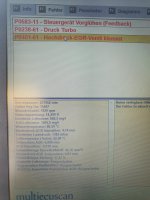 20220508_150815.jpg3.7 MB · Views: 153
20220508_150815.jpg3.7 MB · Views: 153 -
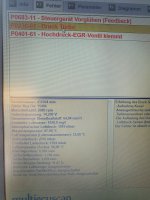 20220508_150812.jpg4.3 MB · Views: 117
20220508_150812.jpg4.3 MB · Views: 117 -
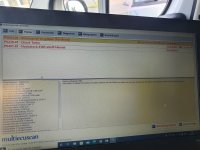 20220508_150801.jpg8.9 MB · Views: 108
20220508_150801.jpg8.9 MB · Views: 108 -
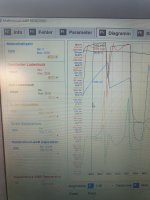 20220508_150251.jpg3.5 MB · Views: 116
20220508_150251.jpg3.5 MB · Views: 116 -
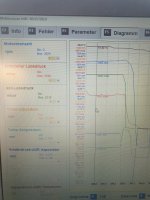 20220508_150157.jpg2.8 MB · Views: 102
20220508_150157.jpg2.8 MB · Views: 102 -
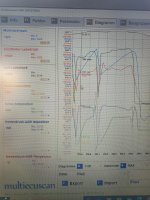 20220508_150000.jpg4.3 MB · Views: 106
20220508_150000.jpg4.3 MB · Views: 106 -
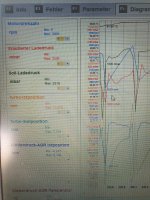 20220508_145633.jpg4.4 MB · Views: 95
20220508_145633.jpg4.4 MB · Views: 95 -
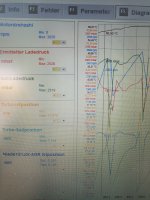 20220508_145419.jpg3.7 MB · Views: 119
20220508_145419.jpg3.7 MB · Views: 119
Fredastaire
Member
- Joined
- Dec 19, 2017
- Messages
- 450
- Points
- 133
Not sure what you mean by 'turboactuator'.
My engine is the 130. There is a vacuum device at the turbo which pulls a lever on the turbo. I would call that the vacuum actuator.
There is a solenoid valve fastened centrally of the scuttle, just behind the vacuum storage air receiver. I'm calling this the vacuum.solenoid.
.
Do you have both and have you replaced both?
.
The black air pipes to and fro the air receiver also need checking for air leaks / cracks etc.
.
The saga continues.......
My engine is the 130. There is a vacuum device at the turbo which pulls a lever on the turbo. I would call that the vacuum actuator.
There is a solenoid valve fastened centrally of the scuttle, just behind the vacuum storage air receiver. I'm calling this the vacuum.solenoid.
.
Do you have both and have you replaced both?
.
The black air pipes to and fro the air receiver also need checking for air leaks / cracks etc.
.
The saga continues.......
kangexpress
Member
I've changed the vaccum solenoid. The one behind the vaccum storage.Not sure what you mean by 'turboactuator'.
My engine is the 130. There is a vacuum device at the turbo which pulls a lever on the turbo. I would call that the vacuum actuator.
There is a solenoid valve fastened centrally of the scuttle, just behind the vacuum storage air receiver. I'm calling this the vacuum.solenoid.
.
Do you have both and have you replaced both?
.
The black air pipes to and fro the air receiver also need checking for air leaks / cracks etc.
.
The saga continues.......
I've got the 150 Multijet. It has also a position sensor for turbocharger position.
The 130 Multijet has no position sensor for the turbocharger.
Vaccum actuator on the turbocharger can't be changed single with OE Parts.
Maybe you can get it from somewhere else as single part.
But from FIAT you can only get the complete turbocharger.
Complete turbocharger has been already changed with remanufactured OE Part.
There is also no problem with vaccum control.
If you look at the MES data you will see that the desired position of the turbo charger is always same as the actual position of the turbocharger.
Turbocharger control is working fine in all load cases and scenarios.
Turbocharger isn't producing enough boost pressure in a certain partial load condition.
(same condition in which the LPEGR is working and open)
Under full load the turbocharger is producing full amount of desired boost pressure and with the correct position of turbo positioning sensor.
If there was a problem with vaccum control it also would be there under full load condition.
The reconditioning of this kind of turbocharger is quite complicated.
Even if I have a reconditioned part from OE FIAT.
Maybe there is a setting problem with the turbocharger itself from factory?
Or there is a part with a micro air leak between turbocharger and intakemanifold which gets tight under full boost pressure and is leaking only under part load?
kangexpress
Member
I've just had the opportunity to compare with a known working vehicle with software version 24.
I've noticed that the LPEGR Temperature is the same like mine.
I've noticed that LPEGR opening mm and opening times are quite less then mine are.
My LPEGR is open 4 mm at 2000 rpm 4./5. Gear for the whole time.
The known good vehicle I've tested opens 2-3mm and closes a for a shorter time period than mine.
Seems like they have adjusted the EGR rate with software update 32.
I've noticed that the LPEGR Temperature is the same like mine.
I've noticed that LPEGR opening mm and opening times are quite less then mine are.
My LPEGR is open 4 mm at 2000 rpm 4./5. Gear for the whole time.
The known good vehicle I've tested opens 2-3mm and closes a for a shorter time period than mine.
Seems like they have adjusted the EGR rate with software update 32.
theoneandonly
Prominent member
@kangexpress the link is to results from my 2017 ducato update 28 with no known issues. There was no temperatures recorded when I did the test . I will try to do a run tomorrow. If you want the .csv file just ask.

 www.fiatforum.com
www.fiatforum.com
Multiecuscan results 2.3 130 euro6 2017 | FIAT Ducato
I did a number of test runs with my Ducato in order to get a base point for a known good engine. No codes 8000miles. The data was collected on a specific test route that i can repeat, about a mile between 2 round abouts. How useful is it should i add a 20mile test route moastly dual...
kangexpress
Member
I've done a test ride today with unplugged EGR.
Unplugged only HP EGR but ECU shuts down both EGR.
And the boost pressure issue disappeared and also differental pressure of DPF is showing normal values.
When EGR plugged in the boost pressure issue comes back immediately.
Have also tested to block the HP EGR with a plate.
But no difference there.
So the boost pressure problem is only there while LP EGR is open.
Unplugged only HP EGR but ECU shuts down both EGR.
And the boost pressure issue disappeared and also differental pressure of DPF is showing normal values.
When EGR plugged in the boost pressure issue comes back immediately.
Have also tested to block the HP EGR with a plate.
But no difference there.
So the boost pressure problem is only there while LP EGR is open.
theoneandonly
Prominent member
LP EGR graph. Warm engine 8 mile journey down one junction on Motorway @50mph and return idle in laybys at begin and end of journey as reminder ecu @28
the opening values are simular to yours at 3-4 mm at 2000-2500 closed at idle. the last plateau at 2000 rpm is when i changed to 6th at about 52mph



the opening values are simular to yours at 3-4 mm at 2000-2500 closed at idle. the last plateau at 2000 rpm is when i changed to 6th at about 52mph
Last edited:
kangexpress
Member
My LP EGR is at 4,5 - 5 mm.LP EGR graph. Warm engine 8 mile journey down one junction on Motorway @50mph and return idle in laybys at begin and end of journey as reminder ecu @28
the opening values are simular to yours at 3-4 mm at 2000-2500 closed at idle. the last plateau at 2000 rpm is when i changed to 6th at about 52mph
View attachment 405647View attachment 405648View attachment 405650
Yours is at 4 mm.
A difference. But not that much.
My LP EGR Temperature doesn't exceed 65 C. Most of the time it's between 50 an 65.
Yours is never under 100.
Is my LP EGR in fact partially blocked?
Even if it's new?
Black smoke because of some other issue.
Bad injectors?
Causing new LP EGR to block again fast.
Is there any third person who can read LP EGR Temperatures?
theoneandonly
Prominent member
@kangexpress
do you know the history of your ecu , when it was updated when and at what mileage?
is the ecu responsible for holding your LPEGR temperature down
Mine has been updated once in march 2019
Graph bellow from same run as last.

do you know the history of your ecu , when it was updated when and at what mileage?
is the ecu responsible for holding your LPEGR temperature down
Mine has been updated once in march 2019
Graph bellow from same run as last.
Baz in Kent
Member
What a nightmare…My LP EGR is at 4,5 - 5 mm.
Yours is at 4 mm.
A difference. But not that much.
My LP EGR Temperature doesn't exceed 65 C. Most of the time it's between 50 an 65.
Yours is never under 100.
Is my LP EGR in fact partially blocked?
Even if it's new?
Black smoke because of some other issue.
Bad injectors?
Causing new LP EGR to block again fast.
Is there any third person who can read LP EGR Temperatures?
Are your injector readings within range as shown in the Fiat service news/bulletin?
: Maximum fuel correction per cylinder (Max fuel correction)
2mm3/H (2 cubic millimetres/hour)
Sum of injectors fuel corrections
0mm3/H (0 cubic millimetres/hour)
theoneandonly
Prominent member
The reason for the LPegr cooler is to reduce temperature of charge going to the Turbo if too low we are condencing the crud indtended to be reburnt and blocking the cooler tea strainer or as you suggestMy LP EGR is at 4,5 - 5 mm.
Yours is at 4 mm.
A difference. But not that much.
My LP EGR Temperature doesn't exceed 65 C. Most of the time it's between 50 an 65.
Yours is never under 100.
Is my LP EGR in fact partially blocked?
Even if it's new?
My injector varianceBlack smoke because of some other issue.
Bad injectors?
Causing new LP EGR to block again fast.
i could have a injector 1 problem?
Is there any third person who can read LP EGR Temperatures?
Fredastaire
Member
- Joined
- Dec 19, 2017
- Messages
- 450
- Points
- 133
The LP EGR is a composite unit. There is the 'penny on a stick' valve which let's the exhaust be sucked in to the turbo. There is a butterfly flap throttle as well. I think that when the LP EGR opens that the butterfly closes to make the turbo suck from the exhaust rather than pull fresh air from the air filter. ( It probably makes a air mix).
.
I think -- that in the case that cooler is blocked; this would mean the butterfly would be strangling the air going in to the turbo - hence you would get the problem that the turbo is unable to get the boost pressure because it's starved of air. At higher engine revs I think that the turbo is able to suck enough air past the partial closed butterfly that the software doesn't see enough error to issue a fault code.
.
the question is - am I correct ?
.
your test with inoperative EGR s would suggest that I may have correct thinking.
.
if yes then we get back to what is causing the sooting problem.
.
I think -- that in the case that cooler is blocked; this would mean the butterfly would be strangling the air going in to the turbo - hence you would get the problem that the turbo is unable to get the boost pressure because it's starved of air. At higher engine revs I think that the turbo is able to suck enough air past the partial closed butterfly that the software doesn't see enough error to issue a fault code.
.
the question is - am I correct ?
.
your test with inoperative EGR s would suggest that I may have correct thinking.
.
if yes then we get back to what is causing the sooting problem.
kangexpress
Member
If you're correct than there are to many options which can possibly cause the sooting problem in LPEGR cooler.The LP EGR is a composite unit. There is the 'penny on a stick' valve which let's the exhaust be sucked in to the turbo. There is a butterfly flap throttle as well. I think that when the LP EGR opens that the butterfly closes to make the turbo suck from the exhaust rather than pull fresh air from the air filter. ( It probably makes a air mix).
.
I think -- that in the case that cooler is blocked; this would mean the butterfly would be strangling the air going in to the turbo - hence you would get the problem that the turbo is unable to get the boost pressure because it's starved of air. At higher engine revs I think that the turbo is able to suck enough air past the partial closed butterfly that the software doesn't see enough error to issue a fault code.
.
the question is - am I correct ?
.
your test with inoperative EGR s would suggest that I may have correct thinking.
.
if yes then we get back to what is causing the sooting problem.
Unfortunately there is no error code which could possibly explain the slight black smoke.
- ecu update 32 problem?
- injector problem?
- differential pressure sensor reading faulty?
- piston rings worn out?
theoneandonly
Prominent member
These 2 examples are for 2000 revs and idle. a dead differential pressure sensor shows itself as not varying with revs and is typically blocked. the injector variance is a way of determining good working injectors. Its been mentioned else the limit is 2 per injector and 1 total.
Some examples of the p401 are relativly low mileage and too early for piston ring problems.


Some examples of the p401 are relativly low mileage and too early for piston ring problems.
Today i took the DPF to the specialist shop, i will get results tommorow. LPEGR was dirty but not in the extent that would block it. LPEGR cooler looked bad, but it was not blocked. It had some resistance, dont know if it was too much. I cleaned all parts between the DPF and the turbine.
Attachments
-
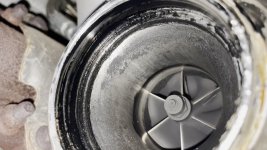 D24180A3-5DBA-48E0-9C62-900721031F01.jpeg328.8 KB · Views: 198
D24180A3-5DBA-48E0-9C62-900721031F01.jpeg328.8 KB · Views: 198 -
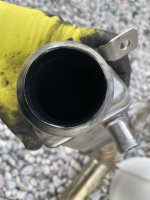 C04D1510-5D26-40B6-B1C7-123D9BAE011A.jpeg1.1 MB · Views: 181
C04D1510-5D26-40B6-B1C7-123D9BAE011A.jpeg1.1 MB · Views: 181 -
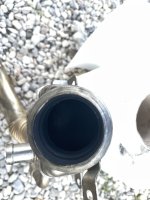 63565515-44AD-442F-94E8-674CA7D93010.jpeg1,002.8 KB · Views: 182
63565515-44AD-442F-94E8-674CA7D93010.jpeg1,002.8 KB · Views: 182 -
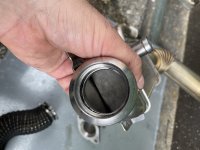 CDF49AD7-AB57-4466-A267-F59AB510BC62.jpeg1.3 MB · Views: 200
CDF49AD7-AB57-4466-A267-F59AB510BC62.jpeg1.3 MB · Views: 200 -
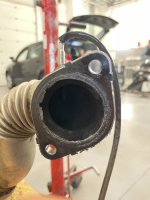 FC8B8DA0-A513-4188-A0C2-F960963E00C2.jpeg978.7 KB · Views: 176
FC8B8DA0-A513-4188-A0C2-F960963E00C2.jpeg978.7 KB · Views: 176 -
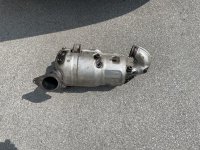 559FA0F8-0CB0-4D75-BEC6-8037FF679110.jpeg7 MB · Views: 184
559FA0F8-0CB0-4D75-BEC6-8037FF679110.jpeg7 MB · Views: 184 -
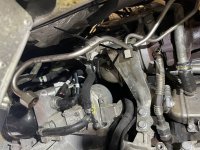 F95DDE5F-A8D6-4444-8739-9B896EC9878F.jpeg3.3 MB · Views: 223
F95DDE5F-A8D6-4444-8739-9B896EC9878F.jpeg3.3 MB · Views: 223 -
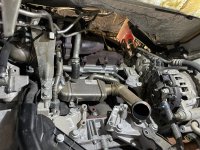 2D12721D-004F-4B39-B2B2-9E4C1E1B7F66.jpeg3.6 MB · Views: 196
2D12721D-004F-4B39-B2B2-9E4C1E1B7F66.jpeg3.6 MB · Views: 196
Last edited:
LPEGR cooler is after cleaning withouth resistance. Some more photos
Attachments
-
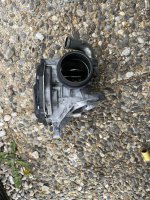 B3B5386E-4232-4702-9C40-831B1B44D5AE.jpeg2.9 MB · Views: 174
B3B5386E-4232-4702-9C40-831B1B44D5AE.jpeg2.9 MB · Views: 174 -
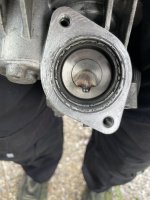 06860B45-704C-491C-89B3-C3ACCCC0256E.jpeg1.8 MB · Views: 196
06860B45-704C-491C-89B3-C3ACCCC0256E.jpeg1.8 MB · Views: 196 -
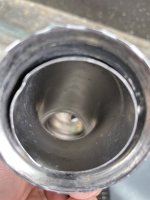 249E2800-C510-4D83-BE7C-E0891B5C4EA4.jpeg1.1 MB · Views: 155
249E2800-C510-4D83-BE7C-E0891B5C4EA4.jpeg1.1 MB · Views: 155 -
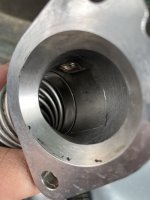 22833CA9-3F71-4F42-AF57-B6C91544E559.jpeg1.1 MB · Views: 150
22833CA9-3F71-4F42-AF57-B6C91544E559.jpeg1.1 MB · Views: 150 -
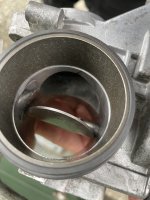 0643A6E1-64DB-4BAB-833A-72252065B9A7.jpeg1.5 MB · Views: 160
0643A6E1-64DB-4BAB-833A-72252065B9A7.jpeg1.5 MB · Views: 160 -
 D480E936-C9F8-424B-A909-CD1EAF4CF1EF.jpeg2.3 MB · Views: 165
D480E936-C9F8-424B-A909-CD1EAF4CF1EF.jpeg2.3 MB · Views: 165 -
 B7E90D43-FE17-409F-B382-F68364B7D25F.jpeg2.2 MB · Views: 180
B7E90D43-FE17-409F-B382-F68364B7D25F.jpeg2.2 MB · Views: 180 -
 7072702E-C22E-4CE7-9939-F4271A461CAA.jpeg3.6 MB · Views: 177
7072702E-C22E-4CE7-9939-F4271A461CAA.jpeg3.6 MB · Views: 177 -
 5F53B80C-8799-43FB-9D49-7BF6FA8E3B17.jpeg3.2 MB · Views: 191
5F53B80C-8799-43FB-9D49-7BF6FA8E3B17.jpeg3.2 MB · Views: 191
Baz in Kent
Member
So far all I’ve been told (by a Fiat Professional workshop (being checked by Fiat Tech in Italy) is that the problem is caused by “the injectors overfuelling”, I’m waiting for an explanation as to why they’ve done this and therefore the solution to stop them doing it.LPEGR cooler is after cleaning withouth resistance. Some more photos
It would be great if someone here can solve this but I suspect unless/until Fiat come up with a solution (software update?) the problems will continue - but what do I know?!
kangexpress
Member
Wow!LPEGR cooler is after cleaning withouth resistance. Some more photos
Nice job.
How long did it take?
How did you managed to get out the LPEGR without taking out the complete engine?
Very skiled mechanic needed 1,5 hours to take of the bridge and the DPF, and another 2,5 hours to take off the LPEGR cooler and LPEGR. It took another 2 hours to clean everyting. You do not need to take the engine out you can do it from the back side of the engine, but need to take off the bridge, exhaust system, some pipes from turbo……
I spoke today with the DPF specialist. In the shop he had DPF from Land Rover (maybe it was Range) with same problems with returning gases from behind DPF, Volvo XC70 has similar problems. The quality of DPF ,material in general is very verry very bad. His statement is: if there is any sooth behind DPF then DPF is broken. So the main question is what is causing the destruction of DPF in Fiat Ducato. All troubles with soooth are coming from broken DPF. What if it is just bad material quality as it is the case with VOLVO XC70? I will have some pictures of the DPF tommorow (hope that they will take them during repair) and will post them. I also had an idea what to change next, i did it and today when driving to mechanic i did not get the p0401 code, i have to test it further….
I spoke today with the DPF specialist. In the shop he had DPF from Land Rover (maybe it was Range) with same problems with returning gases from behind DPF, Volvo XC70 has similar problems. The quality of DPF ,material in general is very verry very bad. His statement is: if there is any sooth behind DPF then DPF is broken. So the main question is what is causing the destruction of DPF in Fiat Ducato. All troubles with soooth are coming from broken DPF. What if it is just bad material quality as it is the case with VOLVO XC70? I will have some pictures of the DPF tommorow (hope that they will take them during repair) and will post them. I also had an idea what to change next, i did it and today when driving to mechanic i did not get the p0401 code, i have to test it further….
Similar threads
- Replies
- 7
- Views
- 963
- Replies
- 51
- Views
- 9K
- Replies
- 1
- Views
- 656

